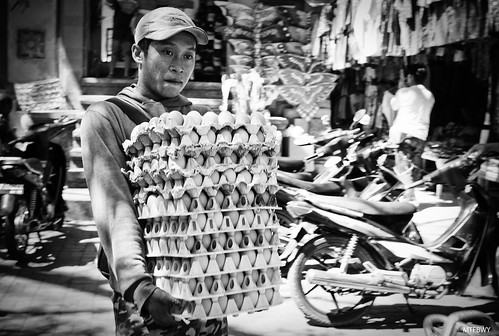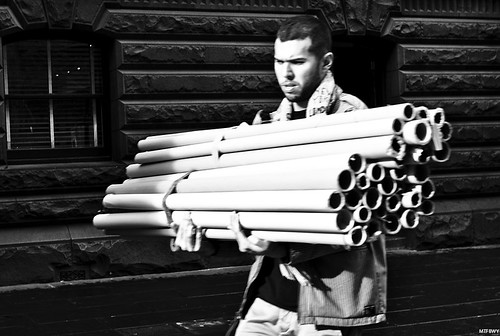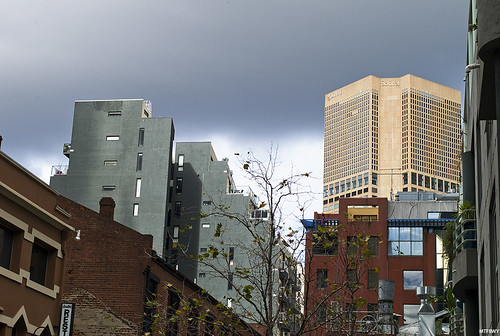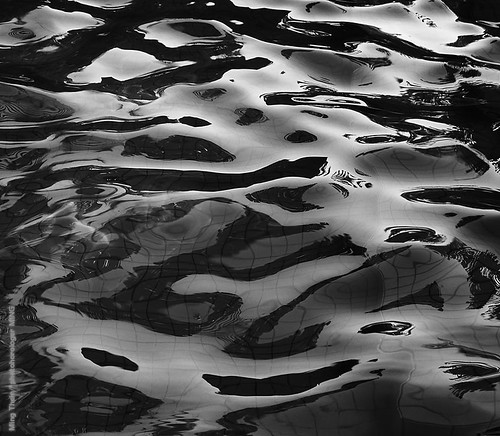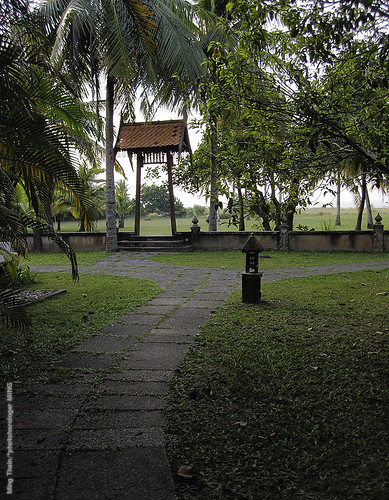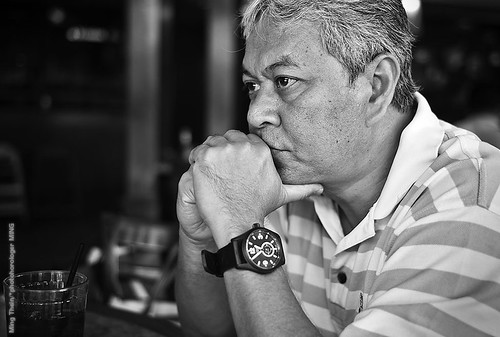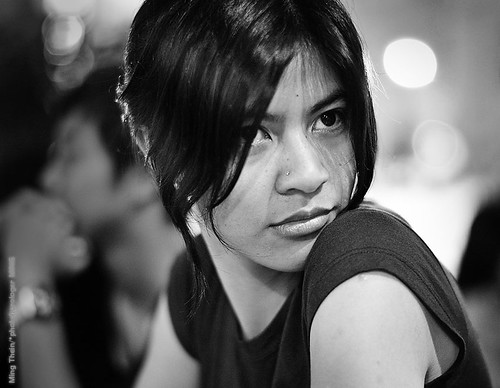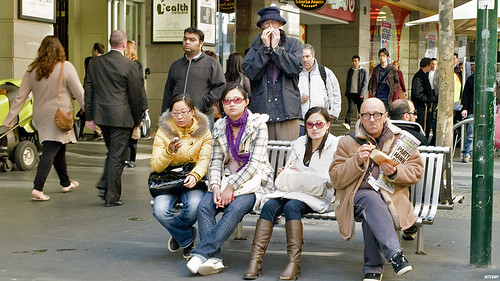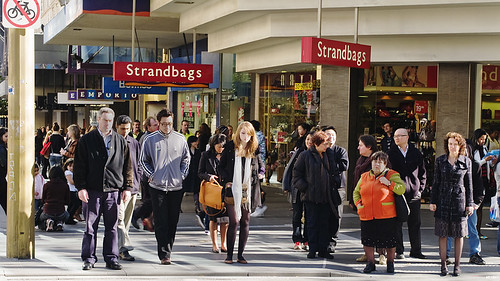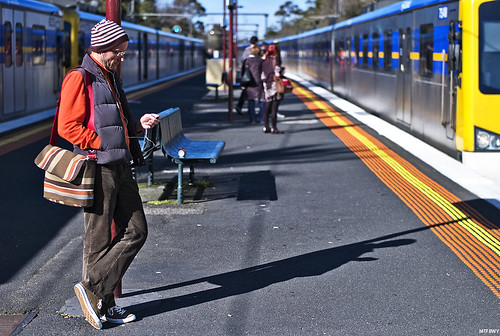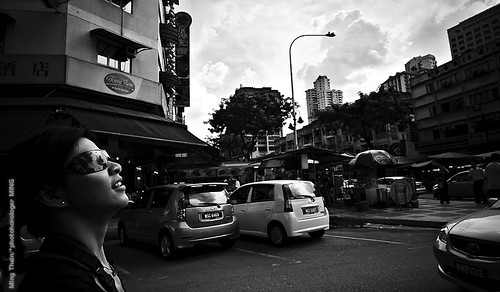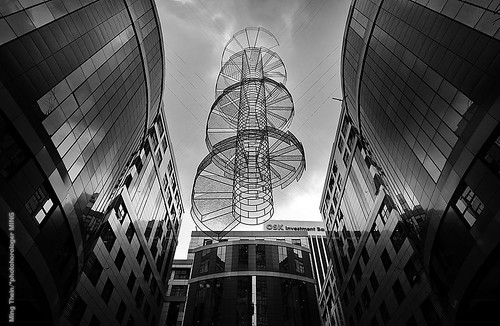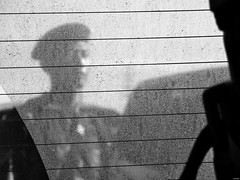are everywhere so it seems. Before we return to regular programming on the Melbourne series, take a look at these two photos, shot in 1000s of kilometers and a month apart, depicting work. They could be colleagues.
Tuesday, July 28, 2009
daily randomness
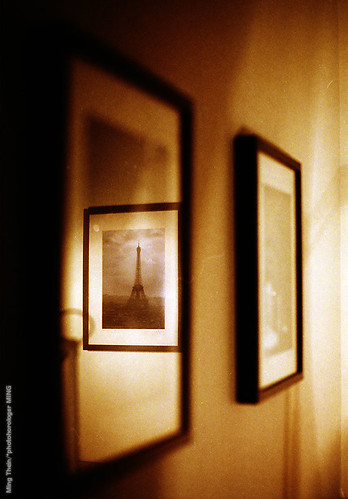
Reflecting on a photograph
Leica M6TTL, Voigtlander 50/1.5 Nokton LTM on Fuji Velvia 100F
Sometimes, photographs make good images in and of themselves.
Labels:
cojones,
fuji velvia,
leica,
m6ttl,
photography,
photos,
random
Monday, July 27, 2009
About Melbourne, Part I...
I used to live in Melbourne, in fact, spent most of my formative years there. One can spend much time in a seemingly foreign place, maintain all sorts of notions of nationality, belonging etc. but still be able to call a city one's 'hometown'. I'm not an Australian, but I'm definitely a Melbournian. This winter, I returned 'home' to spend time with friends and colleagues. It was a great opportunity to walk the streets and make a connection with the city in a way I hadn't experienced in a long while. Since the days of film photography in fact. All photos shown here were taken with a Leica M8, bolted to the now infamous 50mm Summilux 1.4.
what if somebody asked you...
...if it were possible to do photojournalism, at night, with a point and shoot with a cripplingly small 1/2.3" sensor, and a maximum aperture of just f3.2?
I'd give them these as an answer, and tell them size doesn't matter: only what you do with it counts.

Her mother never told her it was rude to stick her tongue out at people.
Canon SD780 IS
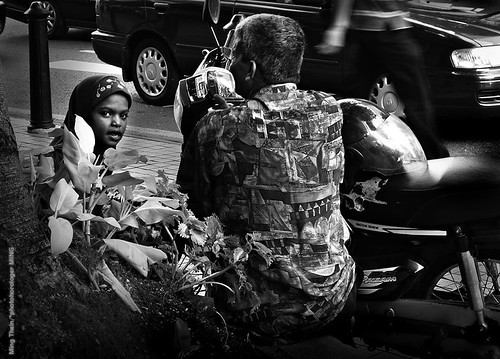
The observation powers of children
Canon SD780 IS

Waiting for dad
Canon SD780 IS

She got their attention
Canon SD780 IS
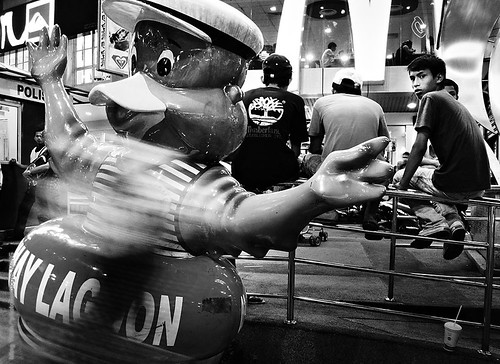
What are you looking at? (other than the bright blue duck)
Canon SD780 IS
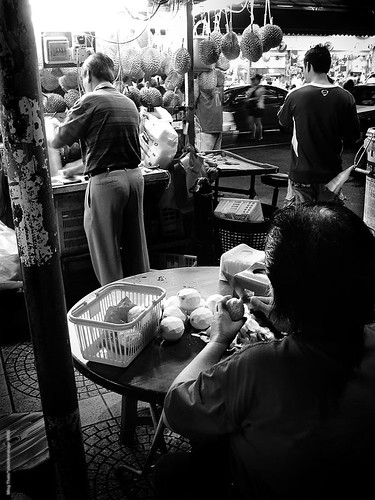
Fruit stall back office processing
Canon SD780 IS
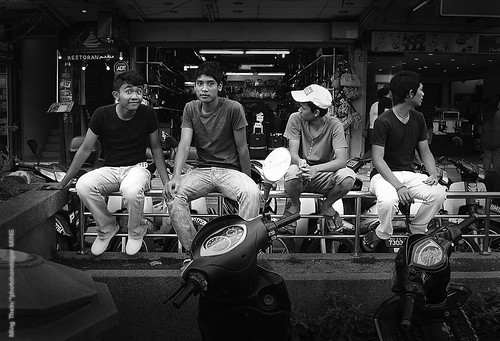
All about the guy on the left
Canon SD780 IS
That last image is my favorite by some margin. Maybe it's because the kids decided to play along and throw me an expression; maybe it's because if I'd tried it with a larger camera they'd probably not have been so friendly, but the image wouldn't be as noisy, sharper, I'd have better isolation blah blah blah...
And this raises a big paradox for me.
You see, it's always a trade off between size/quality and discretion; the motive of ditching the D3 for the M8 was discretion without giving up a lot of image quality (actually, gaining in some areas). For a little over a week, I've been shooting exclusively with the Canon SD780 IS - yes, that little thing I reviewed a couple of posts ago - and finding my creative juices refilled and flowing. I've shot more in a long time (and oddly, seen more images in the world around me) despite not having gone anywhere special, or attended any events. Most of the time I'm pretty sure another camera wouldn't have gotten the shot because I wouldn't have had it on me. Some of the time I wish the image quality was better (and most of the time it's at night - the M8/50 'lux combo is unbeatable); the LCD is very deceptive - stuff that looks great turns out mushy, flat and underexposed on the PC. Stuff that looks too bright and vivid is actually good - go figure. It's going to take some adjustment shooting with this and the D90/ M8, that's for sure (those have 'honest' LCDs.)
Files DO need a lot of work to get them to look like what you see above - but still probably no more than I'd do on a typical M8 RAW file, just different.
So how do I justify having a US$4,000 camera sitting idle doing nothing while I use a US$250 one instead? I can't. And that's the crux of the paradox. If I can do 90% of my work with an M8 instead of a D3, and 95% of that 90% with the SD780 IS...well, seriously, how little camera can you have before you find you can't make the images you want?
Pretty darn little, I suspect. So go out and learn to use what you've got, because it's almost certainly more than you need.
Labels:
available light,
blackandwhite,
canon,
cojones,
compact,
image,
kuala lumpur,
malaysia,
night,
photography,
photojournalism,
photos,
point and shoot,
reportage
Thursday, July 23, 2009
I hate it when people use my images without permission.
The thing is, I don't mind if they have the courtesy to ask - simple enough to send me a message via Flickr where they found the image in the first place. I guess in today's internet society, intellectual property means nothing. At least I got some image credit though, which is better than some other cases.
Image theft is a serious problem for photographers these days. It matters because normally people are willing to pay for images from which they derive commercial benefit, consequently, the photographer would also benefit. It's called stock photography. However, since one no longer needs negatives or prints to use an image - just right click and save - there's no longer any penalty or difficulty.
Using an image without the permission of the copyright holder - i.e. the photographer in most cases - is THEFT. This is ILLEGAL.
Photographers should protect yourselves by using watermarks and never posting full sized printable images online, unless you want to see them used elsewhere. There is some tradeoff between posting a small enough image that you're not at risk of having it jacked against being able to fully appreciate it, but if it's a good enough image in the first place you don't need to see every single pixel.
Be warned and careful...
Monday, July 20, 2009
review: Canon SD780 IS/ IXUS 100 IS
Canon SD780IS/ IXUS 100IS
Nikon D90, AFS 105/2.8 VR Micro with SB900.
Introduction
I'm going to refer to the camera as the 100IS throughout this review to avoid confusion and retyping. As mentioned in a much earlier post, I came over with one of those rare cases of camera lust for the sake of lust - I like this thing purely because of the way it looks, and the size, not anything in particular on the spec sheet - though it does have a couple of neat tricks I'll talk about later. As with all of our reviews, this will be a user experience review with specific comments on image quality where necessary. We're photographers and leave the detailed pixel-level comparisons to sites like DPR.

Yes, it's small. Very small. And only 18mm thick all the way round, with no protrusions - it fits nicely into a pocket.
Nikon D90, AFS 105/2.8 VR Micro with SB900
Features and specifications
It's your standard point and shoot; 12 MP on a rather high density 1/2.3" sensor. I'd personally have preferred even 6 really good MP rather than 12 so-so ones, but as it turns out the camera isn't that bad after all. The lens is a 3x, 33-100/3.2-5.8 thingy that won't win speed or reach contests, but it does have a gyro element to provide optical stabilization. You get a 2.5" LCD, 720P HD movie mode, and amazingly, a miniscule optical zoom finder (actually, the smallest finder I've seen on any camera, period) which is pretty much useless for framing, but not bad for when your shutter speed is dodgy and you need to brace the tiny camera against your forehead. It takes SD/SDHC cards, and there's a HDMI out port.


Mini hut reflections
Canon IXUS 100 IS
Build quality and handling
With something this small and smooth, there are bound to be handling challenges. There's no grip anywhere, so you're best off using two hands - especially when trying to press the recessed buttons on the back, which are quite difficult to distinguish between, particularly in the dark. The camera itself is metal, though the trim that runs between the two shells is plastic, as are the buttons and the memory card/ battery door on the bottom. The latter item is extremely flimsy feeling and I suspect will break quite easily if not handled with care. You do get a metal tripod mount, though. The mix of textures used in the construction actually makes it quite a nicely tactile object to use, and what attracted it to me in the first place. Aside from the stealthy all-black finish, there are also ordinary silver, lipstick red and pimpy gold options available.
Canon IXUS 100 IS
Lens: Canon 5.9-17.9mm 1:3.2-5.8 (33-100 equivalent)
Considering it's size, it's actually surprisingly decent. I think most of the softness I see in the images is due to noise reduction and JPEG processing artifacts rather than lens deficiencies. It's better at wideangle than telephoto though, and has a tendency to flare oddly at the long end. There's no CA that I've seen yet. It isn't up to the standard of the Leica-designed lenses on the Panasonics though. If only this had the 25-125 equivalent on the FX48. Actually, it's not that much of a problem in normal use - most of the time you don't want wide for grab shots, so 33mm is fine. What would be nice is if you could program where in the zoom range the camera started up - I'd probably pick either 35 or 50mm.
Canon IXUS 100 IS
Controls, ease of use and speed
Quite simply, easy, and fast for what it is. I don't think it's quite as fast as my LX3 was, but it's pretty close. The control layout is traditional Canon. It lacks the scrolling D-pad, but I think that's actually a good thing: on a camera this small it'd be far too fiddly to use accurately. There are shortcuts for the usual functions on the D-pad, and a function menu to bring up everything else. Startup and shutdown time is in the region of 1.5 seconds, and shot to shot is virtually lag-free (I'm using a 4GB Sandisk Ducati Edition Class 6 SDHC card).
Canon IXUS 100 IS
Autofocus performance
Focusing is surprisingly snappy despite the slow lens, and if you leave it on Face Detect Ai AF it almost always manages to pick up any people in the scene. It doesn't track moving objects very well, but with the small sensor you can always prefocus and rely on huge DoF to cover subject movement. Minimum focus distance is 5cm in macro mode at the wide end.
Canon IXUS 100 IS
IS performance
The stabilizer doesn't seem quite as effective as that on the Panasonics, but it's definitely better than nothing, and I've had some surprising shots which turned out sharp despite shooting one-handed under iffy lighting. The thing you have to remember with ultracompacts is that you actually need a much higher shutter speed for a motion-blur free picture because they simply don't have the mass to dampen inadvertent photographer motion. Bottom line: you get about 1 extra stop over the 1/focal length rule.
Canon IXUS 100 IS
LCD and image review
I've got a complaint and praise here. The LCD is bright - too bright - and too sharp. It's not accurate in the sense that it doesn't properly represent the image; what looks great and well exposed on the LCD comes out mushy and horrible on a computer. You MUST use the histogram for accurate exposure.
On the positive side, this camera has the best image review options I've seen in a compact. You can set it to show you just the image, the image with a histogram and flashing highlights warning, or a focus point check; unlike Canon DSLRs, you can zoom and delete images from the instant review. You can also jump between focusing points. However, you have to enter full playback mode to jump between images (which you can also do while magnified; useful when comparing images for sharpness from a burst).
And it's shooting priority! A tap of the shutter button returns you to record mode at any time; playback mode is on a button and can also be directly accessed when the power is off. This is the biggest gripe I've got about the latest generation Panasonic cameras, which are so well thought out except for the glaringly obvious flaw of putting playback mode on a switch.
Canon IXUS 100 IS
Metering performance
If you go by the LCD, the meter looks great. But it's conservative and tends to underexpose, so a good rule of thumb is add a stop if your subject is mostly white and subtract one if it's mostly black. Ideally, you should check the histogram - this is especially important because on small sensor cameras like this one, one stop can make the difference between a great image and noisy unrecoverable mush. Matrix, spot and centerweight options are available.
Image quality and noise
Quite honestly, with few exceptions, all compacts these days have fairly similar image quality. The main difference is in how the camera handles noise reduction; Canons tend to be smoother but significantly less detailed. The 100 IS is no exception: detail at base ISO 80 is great, but it rapidly deteriorates to the point where ISO 400 is frequently detail-free, though I've had some acceptable images at ISO 800.
Color isn't accurate at all - honestly, what were you expecting from a JPEG, sRGB only camera? Blues shift towards cyan/green, and reds blow very quickly. It's an unavoidable consequence of having a small sensor with limited dynamic range.
Speaking of dynamic range, it's actually surprisingly good at ISO 80; perhaps 7-8 stops; by the time you get to ISO 800, useable dynamic range is about 4-5 stops at most. And at all costs avoid the i-contrast option; it's too strong and produces very odd histograms where both shadows and highlights land up in the midtones, and as a result images look flat and suffer from gross color shifts - again, usually in the red channel.
In bright light, the camera has a tendency to favor smaller apertures over higher shutter speeds; this leads to noticeable diffraction softening. A pity Canon didn't do it the other way around, because this would have helped both camera shake and resolution.
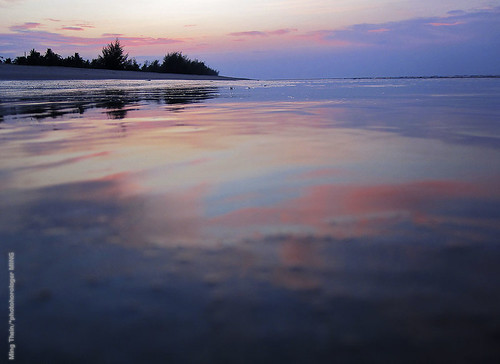
Sunset reflection
Canon IXUS 100 IS
Battery life
Surprisingly good, but the gauge is unreliable (and only has three segments, which I take to be full, half, and "DANGER WILL ROBINSON!"). I'm guessing you could get around 300-400 images with the flash off, and if you limit LCD time. It's a tiny little Li-ion cell, and replacements are expensive. Make sure to charge it before leaving the house.
Conclusion
I bought this because a) I love the idea of a stealthy pocket camera; image quality only has to be acceptable; b) okay, I'm shallow: it looks great. Does it succeed for those two purposes? Undoubtedly yes. There's been a bit of a learning curve with the metering - I would have had many more keepers if I'd known the LCD was so misleading (towards the end of the weekend I was bracketing manually). It's actually so handy that I left the M8 in the hotel room all weekend and only shot with the 100 IS; part of it is new gadget disease but I suspect that it's also partly convenience.
The reality is that this is a camera for when you don't want to carry a camera; when your primary purpose isn't photography (and even an M8 would be too much). It succeeds at that and is actually rather enjoyable to use. It even has neat features like the host of review options. It's faster than the M8 at pretty much everything except release lag. Image quality is pretty good when the light is good (I'd say switch to something with a larger sensor around dusk) - and it's definitely a step above the 'emergency use only' kind of camera that comes lodged in the back of a cellphone. If the M8 is stealthy, this thing is invisible. And that's already gotten me a few shots even the M8 wouldn't have been able to get - if only there was a hyperfocal setting to cut AF lag.
I've owned the LX3, and shot with a G10 and P6000 for an extended period - the serious compacts - and while they were enjoyable, they were all big and unpocketable enough that I wish I'd just carried a proper camera. Result: the point and shoot got left at home all the time, defeating the point. Yes, the image quality of the LX3 is the best I've ever seen in a compact, but under the conditions I'd use it, it's pretty darn close to the 100 IS. You don't need A/S/M modes because they make little difference with a small sensor. The lens isn't anywhere near as good as the LX3 (and practically it has a ~3 stop advantage), but the only one I can pocket and not notice until I need it is the 100 IS - which to me is the whole point. It does what it's meant to without fuss, and for that I'd highly recommend one if a pocket camera is what you're looking for.
Labels:
780 is,
beach,
canon,
cojones,
ixus 100 is,
kuala terengganu,
malaysia,
photography,
photos,
point and shoot,
review
Friday, July 17, 2009
off to a desert island for a few days...
...so I leave you with two images, from the same perspective, but just a slight shift in focus:

Father and daughter I, Kuala Lumpur
Leica M8, 50/1.4 Summilux-M ASPH

Labels:
50,
cojones,
kuala lumpur,
leica,
m8,
photography,
summilux
Wednesday, July 15, 2009
when it's confirmed by the horse, it's no longer rumor-mongering.
I had a meeting with Nikon today. Confirmed for early August launch are:
D300s: D300 with a minor sensor upgrade allowing video mode (I believe a derivative of the D90's sensor, which means better high ISO too). Slightly faster fps.
D3000: Cut down D5000, either no swivel LCD or no movie mode. D60 replacement.
70-200/2.8 VR replacement.
Another lens - apparently Nikon Japan are still trying to decide which one to release first (it appears they have a few optics ready) - the 85/1.4 replacement, or a wideangle prime.
You heard it here first.
Of course you're probably wondering if it's worth the upgrade: unless you're running a D200 or looking to enter the DSLR world, probably not. I don't think there'll be very much difference in image quality - and current offerings are more than sufficient for 99% of 'photographers' out there. The second lens might be interesting, though. I long ago gave up on my 70-200/2.8 because it was simply too heavy to carry around all the time and stayed at home on most occasions anyway.
Tuesday, July 14, 2009
how complicated can it be to build an aperture ring?
For Leica, apparently very complicated:
I've used dozens of Nikon lenses, which all have coupling levers in there too - and the only time I've had an aperture diaphragm fail was when using a 1960s pre-AI 55/1.2 SC on a D2H. At 8fps. That's understandable. But for aperture diaphragms to fail on a rangefinder lens, where the thing doesn't even open and close for every shot...now that's disappointing.
Incidentally, my 50 lux issue still isn't resolved yet. I've very much lost all inspiration or desire to photograph of late. Sigh.
Monday, July 13, 2009
family
Sunday, July 12, 2009
It's about time...

...to change lenses. I've been using the Summilux 50/1.4 since I got into Melbourne. Now it's time to go to the Summarit 35/2.5. Or pick up a Voightlander 15mm Heliar... hmmm....
Reality
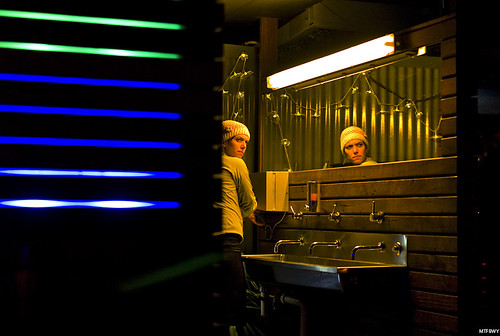
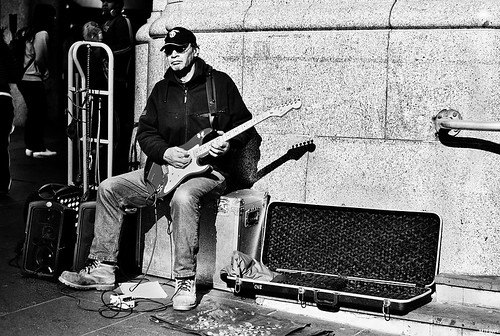

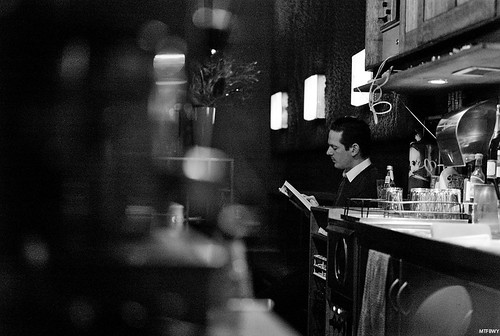
A city changes, just like each component that comprises the greater whole changes, and is amplified into an entire wave of flux. Melbourne as I see it today, isn't the same as when I knew her best. Trips down memory lane are often exhausting. Especially when every turn in the path, each corner revealed, harbour shadows and fragments of impressions. With the passing of time, the image itself fades, and oftentimes, only emotions remain. Even then, I suspect they too might be unreliable. So it's better to see things with new eyes at each instant, so as to refresh and revive.
Saturday, July 11, 2009
Nostalgia
integrity
There are two forms of integrity. The first is pictorial integrity. The second, personal. Both are very important to making a good image; here's why.
Look at this practically though: if you can draw things from scratch in photoshop in a convincing manner, you should probably be an illustrator rather than a photographer. Having done quite a bit of design work myself using Photoshop, I can tell you that it is NOT an easy thing to do. Removing things isn't so hard, but is still a lot of work. Both are no-nos for the honest photojournalist, as is overprocessing. (Oddly, overprocessing in B&W seems to be a lot more forgivable than doing the same in color.) It of course goes without saying that the biggest no-no is in staging the scene. If you get caught doing any one of these things, you can kiss goodbye to your career.
Yet in commercial photography, all of the former things are not only acceptable, but often encouraged and required for a photographer to distinguish themselves from the competition. And the better you are at mastering them, the more you'll likely be paid. Do you see the dissonance here? I certainly do. It only goes to reinforce the conception that all advertising is a lie. It's probably also why there are very few photographers who are at the top of their game both for commercial and photojournalistic work.
Unless you are beyond excellent at your photoshop skills - and even then - it doesn't take long to see when scenes have been artificially composited and altered. Your commercial work then no longer becomes real; if you are trying to portray something so far out of the experience of the average person then the impact is lost somewhat - they have nothing to aspire to. (Isn't that the point of advertising? To make people aspire to something they don't have yet?)
Personal integrity comes into play - more like into question - when you sit back and it stops bothering you that you're using lies to sell crap, or worse, that you're misrepresenting reality rather than portraying it from your point of view. It's a thin line to tread, no question. Then there's the whole issue about whether you're pushing yourself hard enough, giving your best - there's no sadder person than he who lies to delude himself, because nobody will ever be able to convince him otherwise. If you're lucky enough to be given an assignment, then damn well do it to the best of your ability. I especially hate people who are hired to do things that are VERY important to others - read weddings - yet don't really care enough to put their full effort into what is (hopefully) a once-in-a-lifetime occurrence for somebody. I once spoke to a wedding photographer who said that weddings were easy - understand what's going on and just be there to get the moment - I disagree. It's stressful because you have ONE chance to get it EXACTLY right - unlike photojournalism, you can't get it partway right and let the historical significance of the moment carry the shot. That's dishonest. You're doing your clients a disservice, and even worse, deluding yourself.
So for those of you who are really serious about your photography, the next time you shoot, ask yourself if you're doing your level best; if you can't raise your game, even if it's by doing something as simple as forcefully reducing the number of keepers at the end of the day, so the overall standard is higher - then next time you review your archive, you'll have to top it. I know I always try - and that's why there are weeks like this week where I shoot not at all. Since I have the luxury of not being on assignment I'd rather have a few shots where everything comes together perfectly than a boatload of lousy ones.
Thursday, July 9, 2009
ultrawide day lens review 2: Voigtlander 15/4.5 Super-Wide Heliar Aspherical II

Voigtlander 15/4.5 II welded to cojones' stealthified (i.e. electrical-taped) Leica M8
Nikon D90, AFS 105/2.8 VR Micro and diffused SB900
For a while, the Voigtlander screwmount 15/4.5 (21mm equiv.) used to be the widest lens you could get for the M mount - until they brought out the insane 12/5.6, which is so wide you get your knuckles in the photo by gripping the camera normally. It lacked rangefinder coupling - not a big deal when the depth of field scale at f22 stretches 3/4 the way around the lens barrel, but the focus ring only moves 1/4 turn - but for close in work, estimating distances could be a little hit and miss. So Voigtlander made us all happy and released a proper M-mount version earlier this year. I've been shooting with one since launch day (serial # 36!) and couldn't be happier.

Sunset wisps, Kuala Lumpur
Leica M8, Voigtlander 15/4.5 II
Optical performance
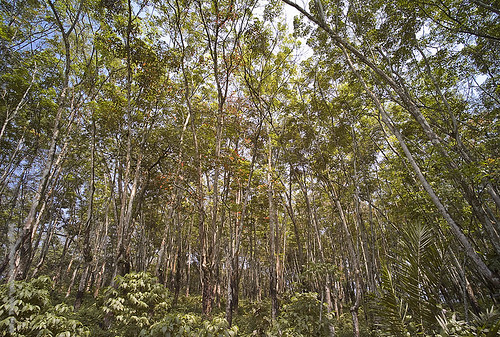
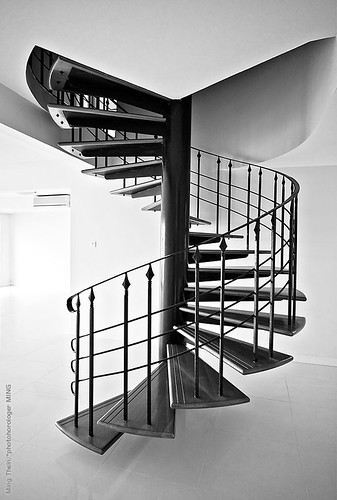
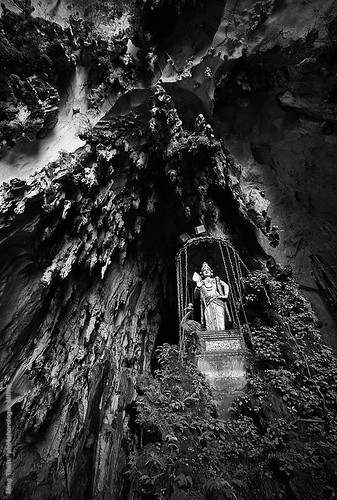
There is really very little to say in this section that is other than good. Designing a wideangle lens for a mirrorless system is significantly easier than for an SLR; you don't have to make a telecentric design, so you can use fewer elements and make the whole optical formula symmetrical, or near to it. It's even easier if the maximum aperture is just f4.5 - not fast by anybody's standards. Fortunately the lens plays nice with lower shutter speeds, as it's so wide you have to be shaking quite a bit for motion blur to be visible in the final image. You can easily get sharp images handheld down to 1/10s.
The image is sharp all over, even in the corners, from maximum aperture to around f16, where diffraction starts taking over (on the M8 at least). Stopping down does not increase sharpness; it's already pretty much maxed out at f4.5, which is not to say it's a mediocre performer - far from it. In fact, on a per-pixel basis, I'd say it's about as sharp as the Leica 35/2 Summicron-M ASPH - which means it sits right up there on my list of sharpest lenses alongside other greats such as the 50/1.4 Summilux-M ASPH (a good copy), the Nikon AFS 300/2.8 VRII N, and the Nikon PC 85/2.5 Tilt-Shift Micro.
I don't see any chromatic aberration.
Contrast is excellent. Look at the shot below: the dark areas were very nearly pure black. Impressive, considering the sky was fairly overcast.
Leica M8, Voigtlander 15/4.5 II
The one area where stopping down does improve things is if you don't like vignetting: the 15/4.5 II vignettes like crazy wide open, perhaps a stop and a half or so on the M8. You can easily fix this if you're shooting RAW and using Photoshop, of course. Personally, I like it; it adds to the look and feel of the image. I'm guilty of even adding more sometimes - both to images shot with this lens, and more clinical lenses like the 35 'cron and 50 'lux.
It's difficult to comment on color transmission because I don't have a 52mm UVIR filter to go on the front, and we all know how responsive the M8 is to wavelengths we can't see. But in a quick and dirty comparison, color rendition is similar to the 35/2 Summicron-M ASPH without a UVIR filter - which suggests similar optical transmission properties.
Let's not bother talking about bokeh because there isn't any with a lens this wide and slow.
Build quality and tactility
I must be one of the few photographers who puts an inordinate amount of importance on the way a lens handles: I like things that feel like vintage instruments, rather than melted plastic superblobs which have billions of buttons that do different things depending on which mode you're in, and which other button you've held down. Leica lenses feel amazing (at least those ones that aren't defective!). They're very smooth and precise without having any slop or backlash. And the weight adds to that feeling of solidity. Zeiss is pretty close, but they use more aluminum so they don't feel quite as solid.
Voigtlander is somewhat variable - the 50/1.5 Nokton Aspherical I also have is both light yet reasonably solid and precise at the same time, but the focusing ring has some backlash and drag that makes it easy to shift slightly off the critical point of focus. On the other hand, if the 15/4.5 II had the Leica badge on the front, I don't think I'd have expressed any disappointment at the build quality. It's nicely made, precise, without slop, and the aperture stops have a nice positive click to them. The built in hood is to protect both the front element and stop you from sticking your fingers into the frame (admittedly, I've done that a couple of times when not paying attention - you really need to use an external finder, but I find them inconvenient so I don't bother and just guesstimate the frame coverage). If I was to nitpick, the only place where the build quality lags a little is the lack of beveling on the ring edges: look at a Leica lens and notice how focusing and aperture rings are beveled.
But I digress. Let's just say that for the money, in fact, any money, it's a little jewel.

Trying to see the forest for the trees (on the full size image, I can make out individual leaves in the corners. Sharp enough for you? It is for me. And that was shot wide open...)
Leica M8, Voigtlander 15/4.5 II
Conclusion
At US$500 or so, and considering the target audience of Leica M shooters, this lens is not only a bargain, but unique: the only similar focal length Leica has is in the 16-18-21 Tri-Elmar, and that's horribly expensive and huge. It's also not as sharp. The Voigtlander 15/4.5 II, on the other hand, is so small that you could conceivably lose it in a large pocket. It feels great to use. And the optics are fantastic.

Spiral III, Kuala Lumpur
Leica M8, Voigtlander 15/4.5 II
Above all of that, though, I love the way this lens draws. I can't put my finger on it. It's contrasty, sharp, and vignettes to produce what I always think of as that classic 'rangefinder look'. I loved the 24mm length on my D3, but sometimes wanted wider. At 21 equivalent, the 15/4.5 II is nearly perfect. Now if only it could be a stop faster so I could use it at night and indoors. It's also great for fast shooting: use the depth of field scales to prefocus, aim in vaguely the right direction (the huge FOV takes care of the rest) and bang away.
Recommended? Definitely. Do you need the finder too? I don't know. Personally I don't bother, since RF framing is so loose anyway and this is a zone-focus-shoot-from-the-hip lens anyway. So, stop wasting time and go buy one. Then make pictures. Done.

Cave god, Batu Caves, Kuala Lumpur
Leica M8, Voigtlander 15/4.5 II
ultrawide day lens review 1: Nikon AFS 10-24/3.5-4.5 DX G

Introduced as a companion lens to the D5000, the AFS 10-24/3.5-4.5 DX G now becomes the widest rectilinear lens (15-36 equivalent) in the Nikon stable, ousting the former AFS 12-24/4 DX. It doesn't bear the gold ring though, which suggests somewhat lower expectations might be in order.
Like all of our equipment reviews, this one will be from a practical photographer's standpoint and experience. There won't be 100% crops or resolution charts unless there are some real optical exceptions going on; go to DPR or SLR Gear for that. I'm more interested in how the lens draws when I'm trying to make images with it, not how many lines it resolves or whether f5 is sharper than f5.6.
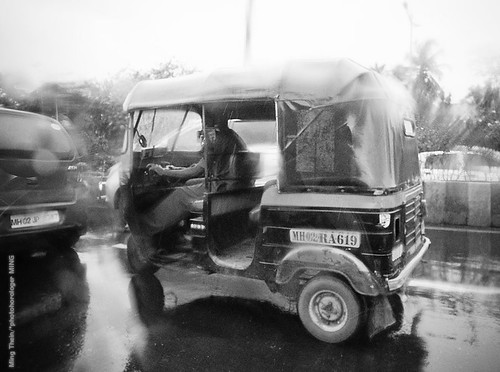
Rain, Mumbai
Nikon D90, AFS 10-24/3.5-4.5 DX G
Optical performance
Although the spec sheet reads suspiciously like the Tamron 10-24/3.5-4.5, the internal configuration is different: 14 elements in 9 groups against 12 elements in 9 groups for the Tamron. This is a good thing, because the Tamron is a bit of a dog. Unfortunately, the Nikon 10-24 doesn't come close to the AFS 12-24/4 DX, let alone the AFS 14-24/2.8 N. The two samples I tried show serious concave field curvature, most noticeable at the wide end. This is to say that if you use the center point on a subject at infinity, the corners will be soft. But if you use the edge points, then the depth of field takes care of the center and the whole lot looks pretty decent. Just to make sure it wasn't the camera's AF system out of whack, we tried it on two D90 bodies to be sure - both of which focus perfectly with other lenses - still no dice.
The good news is that when properly focused, sharpness is decent from wide open, but peaks around the point where diffraction starts taking over - f11 or so on a 12MP DX body.
The bad news is that there is quite a lot of lateral chromatic aberration on corner highlights, and some seriously weird higher order distortion going on: this isn't a lens you'll be able to correct for using the Camera Raw tools.
Contrast improves markedly when stopped down, suggesting internal flare.
No point talking about bokeh because you can't throw anything out of focus with a lens this wide and slow.
Interestingly, though billed as a DX only lens, the 10-24 will cover the full FX frame from 15mm upwards with some vignetting. As you might have expected, the corners are crap though.
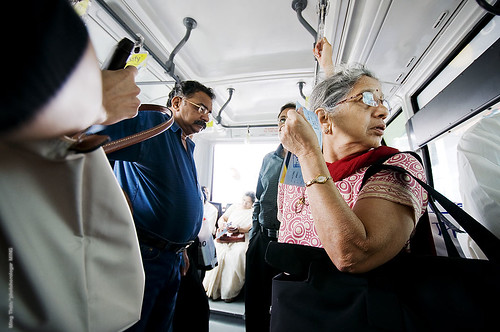
Crap, that was my stop! Mumbai
Nikon D90, AFS 10-24/3.5-4.5 DX G
AF performance
It's fast enough, given infinity to close focus (a bit under 0.24m) is barely a sixth of a turn. More worrying is that with the D90, autofocusing on a subject at infinity yields anywhere between 5m and infinity on the ring scale - the depth of field is just so great that precise focusing is tricky. At least it has a distance scale, though.
Catching up on the news
Nikon D90, AFS 10-24/3.5-4.5 DX G
Build quality
Plastic, all plastic. I suspect some of the lens elements are plastic too ("moulded hybrid aspherical"). The front takes 77mm filters and the same hood as the 12-24, 17-35 and 18-35; not quite deep enough and a pain to store because it's so wide. You'll need it though, because this thing flares like the Shuttle on landing. The lens mount is metal, and the zoom ring is rubberized, though the focusing ring is urethane-coated plastic. Said urethane coating isn't terribly durable because it's already peeling and I don't remember storing the lens together with anything else in the same compartment. There is a rear gasket, though I doubt the rest of the lens is sealed. In short: standard Nikon consumer-grade, though it appears the focusing ring is a bit worse than normal. (I've never seen the urethane coat peel before).
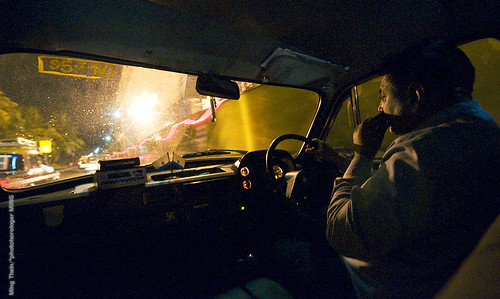
Taxi man, Mumbai
Nikon D90, AFS 10-24/3.5-4.5 DX G
Conclusion
At US$850 new here, I'd skip this one and get the older 12-24/4 second hand for bout US$700 instead. It's better built, optically much better (sharp into the corners, minimal lateral CA, no field curvature) and you don't give up that much on the wide end. The 10-24 is in no-man's land: it's expensive, not as good as alternatives (the Tokina 11-16/2.8 comes to mind - it's all metal AND f2.8!) and used value is likely to plummet like a brick once people discover the older one is better. Buy it only if you absolutely need 10mm on DX - since such people are far and few between, and usually shoot professionally, I'd suggest the 14-24 on a D700 instead. Personally, all my wide needs are served by the excellent Voigtlander 15/4.5 Super-Wide Heliar Asph II (to be the subject of another review) on the M8, which has none of this optical silliness and is about the same size as a Nikon rear lens cap.
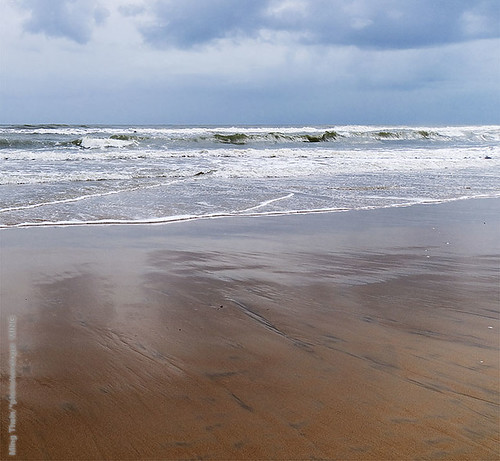
Reflections, Goa
Nikon D90, AFS 10-24/3.5-4.5 DX G
Subscribe to:
Posts (Atom)
